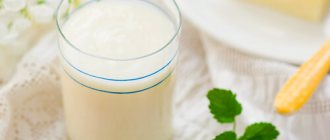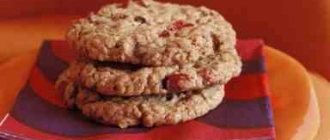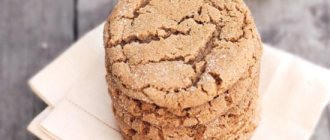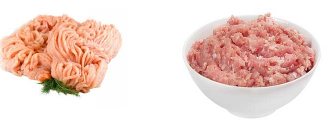No one will probably be able to say exactly how many varieties of cookies exist today. Soft, hard, flaky, buttery, shortbread, sweet, salty, filled, with glaze - the list can go on for a very long time, since cookies are one of the most favorite delicacies and many recipes have been invented since the birth of this dish.
Cookies are a tasty and satisfying confectionery product; they are stored for a long time and are convenient to store and transport (for example, cookies can be taken with you on a trip and they will not spoil or crumble). However, the calorie content of cookies, like any sweet dish, can be quite high
. How many calories are in cookies depends on the type of dough, as well as additives, fillings, icing, etc. The more sweet ingredients in the dish, the higher the calorie content of the cookies.
Confectioners distinguish several main types of cookie dough - sugar, shortbread, butter, puff pastry, puff pastry, whipped and oatmeal. They are all different: for example, sugar dough is kneaded in kneading machines, it is sweet, porous, but quite fragile. Prolonged dough is less sweet and fatty, it has a more elastic and dense structure. Cookies made from butter dough are sweet; the dough contains a lot of fat and eggs. Oatmeal cookies are made from oatmeal with the addition of flour and sugar; they are sweet, hard, and can be consumed during diets, as they contain a lot of fiber, which is good for digestion and figure.
As mentioned above, the calorie content of cookies depends on the ingredients included in the dough and filling. The sweeter the dough, the more fat it contains, the higher the calorie content of the finished cookie. The highest calorie content of cookies is obtained from premium wheat flour
, and rye, oatmeal, whole grain cookies are less calorie and more healthy. Calorie content of cookies with sweet filling, nuts, icing, chocolate, etc. much higher than without these tasty but harmful additives.
Calorie content of biscuits
Galette cookies are the least high-calorie of all types of cookies due to their extremely low sugar and fat content. It’s not for nothing that this type of cookie is allowed (and sometimes even recommended) in various diets. Various ingredients can be added to the dough recipe for its preparation - oatmeal or rye flour, corn, caraway seeds, poppy seeds, vanilla, as well as confectionery fats. All this affects the calorie content of biscuits. Naturally, the more different additives it contains, the higher it is. However, it is not only the low calorie content of biscuits that is beneficial, but also its rich vitamin and beneficial composition - it contains B vitamins, PP vitamins, as well as potassium, selenium, zinc, copper and other micro- and macroelements.
Calorie content of oatmeal cookies
Despite the rather high calorie content of oatmeal cookies - about 420-440 kcal per 100 g - they are quite beneficial for digestion due to their fiber content. Today, there are varieties of dietary oatmeal cookies prepared with less fat, without using premium flour (or replacing it with rye, oatmeal, bran flour, etc.), and with less sugar content.
The calorie content of dietary oatmeal cookies is significantly lower and amounts to 350-380 kcal per 100 g, but they are harder and less sweet than regular oatmeal cookies. The usefulness of dietary oatmeal cookies is also explained by the fact that palm oil and hydrogenated fats (for example, margarine), which are extremely harmful to human health, are not used in their preparation.
You can make the healthiest oatmeal cookies at home from natural ingredients - oatmeal, whole grain flour, real chicken eggs (not powdered eggs used in the food industry), prunes or dried apricots, real honey instead of sugar. The calorie content of cookies prepared at home will be lower than those produced industrially.
, and the benefits from it will be many times greater than the benefits from the purchased one.
Oatmeal cookie dough is prepared from a glass of oatmeal, 2 tablespoons of honey, 2 egg whites, 2 tablespoons of flour and a pinch of salt. The calorie content of oatmeal cookies according to this recipe will be 345 kcal per 100 g, and if you replace honey with raisins, it will drop to 330 kcal per 100 g.
Calorie content of homemade oatmeal cookies per 100 grams
The calorie content of dietary oatmeal cookies per 100 grams is 170 kcal. 100 g of sweets contain 9 g of protein, 5.2 g of fat, 21 g of carbohydrates.
To make cookies you need the following ingredients:
- 0.2 kg of rolled oats;
- 2 eggs;
- 0.2 kg cottage cheese;
- 0.2 kg apples;
- 1 banana;
- 2 g cinnamon.
Recipe:
- oatmeal is fried without oil;
- finely grate apples and banana;
- cottage cheese, eggs, bananas, apples, cinnamon are thoroughly mixed;
- Cookies are made from the resulting dough;
- The liver is placed on baking paper and baked at 150° C until ready.
Calorie content of shortbread cookies
This type of cookie is soft, distinguished by a sweet taste, often with various additives - chocolate, honey, jam, condensed milk, etc. The calorie content of classic shortbread cookies (without additional additives) is 383 kcal per 100 g.
Adding additional ingredients, fillings, glazes, etc. increases the energy value of cookies. For example, the calorie content of Kurabye shortbread cookies with jam is 410-425 kcal per 100 g
, and the calorie content of cookies with nuts is 407 kcal per 100 g.
Energy value of cookies from famous manufacturers
Cookies "Yubileinoe" are a bright representative of sugar cookies. The product is well known to almost all Russians; the packaging and characteristic taste are familiar from childhood. The delicacy has many fans, because it melts in the mouth, has a delicate structure, and is easy to snack on. However, not everyone knows that the product is high in calories. Jubilee cookies have a calorie content of about 472 units per 100 grams. One cookie weighs approximately 14 grams, therefore, the calorie content of 1 piece of Yubileiny is 57 units.
- Jubilee Morning Cookies - calorie content 457 units per 100 g
- Cookies Maria calorie content - 400 kcal per 100 g. Biscuits are made from premium quality wheat flour. The energy value of 1 Maria cookie is about 40 kcal (approximate weight 10 grams)
- Yashkino cookies - calorie content 500 units per 100 g
- Approximate calorie content of Lyubyatovo cookies (Maria biscuits and crackers) - 410 units
- Oreo cookies - calorie content 500 units per 100 grams
Calorie content of Yubileiny cookies
In order to reduce the cost of its production, many “chemical”, non-natural components are currently added to Yubileiny cookies, such as various flavors, emulsifiers, preservatives, as well as other harmful ingredients - for example, palm oil. All this makes the calorie content of Yubileiny cookies high, and the benefits for human health low.
The calorie content of “Anniversary Classic” cookies is 435 kcal per 100 g.
There are also various types of these cookies with the addition of ingredients not provided for in the classic recipe: cocoa, fruits, berries, with yogurt filling, etc. They are higher in calories and have a higher content of unnatural ingredients, since most additives are produced in the food industry using chemicals that are harmful to human health.
“Anniversary” cookies, calorie content and recipe features
The classic Jubilee cookies, produced by confectioner Adolf Siu at the end of the 19th century, consisted of wheat flour, powdered sugar, corn starch, milk, margarine and eggs. In Soviet times (mid-50s), invert syrup, soda, food essence and ammonium were added to the cookie recipe.
But all these ingredients look like harmless culinary tricks compared to what is added to Jubilee cookies today: palm oil (cheap vegetable fat), flavorings (Vanilla-Milk, etc.), soy lecithin (emulsifier) and preservatives. Natural ingredients are a thing of the past; they have been replaced by chemical substitutes that are harmful to health.
Today, several types of Yubileiny cookies are produced, the calorie content of which differs and depends on the components included in their composition:
- Calorie content of classic Yubileinoye cookies is 433.8 kcal/100 g;
- Cookies “Anniversary Morning” - 455.5 kcal/100 g;
- Cookies “Anniversary with cocoa” – 447 kcal/100 g;
- Cookies “Jubilee with fruits and berries” - 460 kcal/100 g;
- The calorie content of the Yubileiny sandwich cookies with cocoa and yoghurt filling is 465 kcal/100 g.
How to reduce the calorie content of cookies at home
When making cookies at home, you can adjust the calorie content at your discretion. Replace wheat flour with lower-calorie oatmeal, corn, etc., reduce the amount of oil in the recipe, as well as sugar. Replace sugar with honey, dried fruits, jam - even if this does not reduce the calorie content of cookies, it will clearly increase their usefulness.
Use only natural ingredients with reduced fat content, for example, skim milk, 10% fat sour cream.
Avoid using animal and confectionery fats, use butter or vegetable oil. If you liked this article, please vote for it:
(28 Votes)
Calories, kcal:
Proteins, g:
Carbohydrates, g:
Oatmeal cookies are a rich delicacy with a familiar taste from childhood. The cookies have a round shape, golden brown color, the inside is different in color, has a wheat tint, the center is quite soft, and on top there is a crispy crumbly layer of dough. Oatmeal cookies have a textured consistency; small oat grains are clearly felt. Oatmeal cookies may differ in taste from different manufacturers, depending on the additives - or dried fruits.
Calorie content of oatmeal cookies
The calorie content of oatmeal cookies is approximately 437 kcal per 100 grams of product, depending on the recipe.
Classic oatmeal cookies should contain:, (or), and. Due to the presence of wholemeal oatmeal, the product contains indigestible dietary fiber, which, passing through the gastrointestinal tract, takes in not only waste and toxins, but also removes cholesterol (calorizator). The product contains a small amount of vitamins and minerals, but under the influence of high temperatures most of them disappear. The carbohydrates that make up oatmeal cookies saturate the body for a long time and charge you with energy.
Harmful oatmeal cookies
The high calorie content of oatmeal cookies makes the delicacy dangerous for those watching their weight. Some ingredients of the product are allergens, so cookies should be used with caution by anyone who is prone to allergic reactions.
Selection and storage of oatmeal cookies
When choosing ready-made oatmeal cookies, you should carefully study the composition of the product and its shelf life. Many manufacturers add preservatives, flavor enhancers and other E-additives to cookies, which are not always harmless. Therefore, even if the ingredients are difficult to read due to the small print, a too long shelf life indicated on the package should be a reason to refuse the purchase. A visual inspection will help assess the integrity of the cookies; if there are any broken ones, they will be dry and hard. You need to store oatmeal cookies in a glass container with a well-fitted lid, then the cookies will retain their organoleptic properties for 7-10 days.
Oatmeal cookies in cooking
Oatmeal cookies are ideal for tea or coffee, with a glass or - an excellent healthy afternoon snack for children and adults. Of course, oatmeal cookies can be prepared at home; unusual ideas and new recipes are available in our article.
For more information about oatmeal cookies, watch the video “Expertise of oatmeal cookies and ten products that save you from blood clots” from the TV program “NashPotrebNadzor”.
Especially for Copying this article in whole or in part is prohibited.
Almost every one of us loves sweets. One of the simplest and most delicious desserts is cookies, a popular treat among adults and children. But, like all sweets, the calorie content of cookies is quite high, so people who want to get their body in good shape most often deny themselves the pleasure of enjoying their favorite dessert.
Chemical composition of cookies
What components are included in the mixture for making cookies, and what substances does it consist of, which is tasty, but not the healthiest product? It is impossible to fit all existing cookie recipes into one article, because there are simply too many to count. Almost every country has its own traditional varieties of cookies, the recipe of which is customized by the owner or manufacturer. And while additional ingredients may vary depending on the recipe, the main components remain the same - flour, eggs, oil (vegetable or butter), sugar and salt. Depending on the recipe and type of cookies, honey, sour cream, dried fruits, nuts, cottage cheese, cocoa, and chocolate can be added. These products themselves are high in calories; it is not surprising that, when “combined” together, they turn into not the most dietary product.
The calorie content of cookies is also affected by the type of flour used to prepare the delicacy. The most high-calorie cookies are made from wheat flour, and instead of it or in combination with it, rye, corn, oatmeal, or wholemeal flour can be used. To reduce calories, sugar is sometimes replaced with honey or fructose.
Cookies have a high calorie content per 100 grams, but at the same time contain many useful substances. It is rich in B vitamins, vitamins A and E, contains calcium, sodium, phosphorus, magnesium, potassium, iron. Oatmeal cookies also contain a lot of fiber, so some of its varieties can be eaten even on a diet, of course, in moderation.
An approximate BJU of cookies looks like this:
- Proteins - 7.5 g
- Fat - 11.8 g
- Carbohydrates - 74 g
The nutritional value of the product, as well as the calorie content, changes in accordance with the cooking recipe.
The benefits and harms of cookies for those who are losing weight
Since this baked product is a butter product, its excessive consumption has a negative impact on the figure.
However, cookies also have beneficial properties:
- the product is rich in vitamins (PP – 0.7 mg, B1 – 0.08 mg, B2 – 0.08 mg) and microelements (iron – 1 mg, potassium – 90 mg, phosphorus – 69 mg, magnesium – 13 mg, sodium – 36 mg, calcium – 20 mg) necessary for the normal functioning of the human body;
- improves brain functioning, increases the resistance of the nervous system to external stimuli;
- sugar, in combination with vitamins and minerals, saturates the body with energy, and therefore cookies are recommended for consumption by both adults and children.
On the other hand, you should not abuse this product - this is a direct path to excess weight gain, dental problems and gastrointestinal diseases.
Calorie content of cookies of different types
There is a huge variety of varieties of this product. The most common types have remained for many years:
- biscuits;
- oatmeal;
- butter;
- chocolate;
- lingering;
- puff pastry;
- sand;
- homemade.
The calorie content of cookies can be increased by the presence of icing, fillings and other additives, so when choosing, you need to pay attention to them.
Biscuits
If we consider which cookies have the least calories, biscuits will be the leader on this list: they are often even recommended for use on diets. Dry biscuits can be made from various types of flour, sometimes poppy seeds, vanilla, and caraway seeds are added to them. They contain minimal sugar and no chocolate or glaze that could increase the energy value. These cookies are rich in vitamin and mineral composition. On average, the calorie content of biscuits is 395 kcal per 100 g of product.
One of the subtypes of biscuits is a cracker (only 350 kcal per 100 grams), which is also sometimes allowed to be consumed on a diet as a snack.
Oatmeal
Oatmeal cookies have a fairly high calorie content - approximately 440 kcal per 100 g.
This type is different in that:
- contains a large amount of fiber, which helps improve digestive functions;
- can quickly satiate and satisfy the need for sweets. Even 1 piece. Such cookies (approximately 20-25 g, 85 kcal) can dull the feeling of hunger. Therefore, it is sometimes recommended for people on a diet.
Sand
And the use of various fillings and additives makes shortbread cookies even more high in calories and less healthy for those who want to lose weight.
Puff
Puff pastry is also not advisable for those who are trying to lose weight.
The calorie content in it ranges from 500 to 600 kcal per 100 grams, and at the same time the nutritional value of such a product is quite high:
- carbohydrates – 58.9 g;
- proteins – 7.7 g;
- fats – 14.3 g.
Chocolate cookies
Chocolate chip cookies are a favorite cookie for many people. Its calorie content per 100 grams is 500 kcal, i.e. per 1 piece. medium size has about 79 kcal.
Considering that when losing weight it is advisable to consume no more than 1400 kcal per day, such baked goods are not recommended for diets.
How many calories are in cookies: nutritional and energy value
The calorie content of cookies depends on the type of culinary product and the ingredients used for its preparation.
The nutritional value and calorie content of oatmeal cookies per 100 g is:
- Proteins – 5.6 g;
- Carbohydrates – 74.3 g;
- Sugar – 31.05 g;
- Fats – 14.87 g;
- Calorie content of oatmeal cookies – 434 kcal;
- Saturated fat – 4.2 g;
- Monounsaturated fats – 10.17 g;
- Polyunsaturated fats – 2.46 g;
- Cholesterol – 0 mg;
- Fiber – 2.16 g;
- Sodium – 230.4 mg;
- Potassium – 93.6 mg.
The nutritional value and calorie content of Jubilee cookies per 100 g is:
- Proteins – 7 g;
- Carbohydrates – 66 g;
- Water – 2.98 g;
- Calorie content of Jubilee cookies – 463 kcal;
- Water – 0 g;
- Fats – 19 g.
The nutritional value and calorie content of biscuits, per 100 g, is:
- Proteins – 9.45 g;
- Carbohydrates – 66.58 g;
- Sugar – 31.05 g;
- Fats – 9.35 g;
- Calorie content of biscuits – 394.53 kcal;
- Water – 2.78 g;
- Dietary fiber – 0 g;
- Sodium – 0 mg.
The nutritional value and calorie content of shortbread cookies per 100 g is:
- Proteins – 5.038 g;
- Carbohydrates – 53.044 g;
- Sugar – 12.43 g;
- Fats – 19.84 g;
- Water – 2.78 g;
- Saturated fat – 5.01 g;
- Monounsaturated fats – 11.04 g;
- Polyunsaturated fats – 2.66 g;
- Calorie content of shortbread cookies – 411.29 kcal;
- Cholesterol – 20.56 mg;
- Fiber – 1.028 g;
- Sodium – 370.08 mg;
- Potassium – 82.24 mg.
How to reduce the calorie content of cookies when cooking at home
Those who strictly follow a diet, but want to treat themselves to a delicious dessert, can prepare homemade cookies. In this case, it becomes possible to control the energy value of the final product and reduce this indicator.
To reduce the calorie content of homemade cookies, you can:
- use low-calorie flour, such as corn or oatmeal, instead of wheat flour.
- You can use honey or banana puree as a binding component, this will make homemade cookies more healthy;
- For the dough, you can use not a whole egg, but only the white (not as high in calories as the yolk).
- It is recommended to give up sugar in favor of honey, fruits or natural sweeteners. In this case, the calorie content of the cookies will be slightly lower, and the benefits of baking will be greater;
- If sour cream or milk is used in baking, you should select products with a low fat content.
The materials posted on this page are informational in nature and intended for educational purposes. Site visitors should not use them as medical advice. Determining the diagnosis and choosing a treatment method remains the exclusive prerogative of your attending physician.
Similar articles
Dried apricot is a dried apricot that retains most of the beneficial properties of the fresh fruit. Dried fruit is valued for its high content of microelements and…
Often, many people mistakenly refuse to eat butter, considering it too fatty and harmful, while a small amount of butter in…
Borodino bread has an original sweet-salty taste and pleasant aroma due to coriander and caraway in its composition. Thanks to its dietary properties and…
Pork is one of the most popular types of meat, widely used due to its unique taste and aroma. However, despite its…
Liver, cakes, and muffins cannot be classified as dietary dishes, and if you really want to lose weight, you will have to give up these confectionery products. Their calorie content is very high; just 100 grams of any of these products contain at least 300 calories. Moreover, all these products are harmful to health. Recently, palm oil and other refractory vegetable fats that are not digested in the body have been added to confectionery. Most confectionery products contain flavoring additives, dyes, leavening agents, and preservatives. All this chemistry is needed to extend shelf life and improve taste. But for the human body, all this is poison. Therefore, if you are serious about your health and the health of your loved ones, exclude all confectionery products from your diet or reduce their consumption to a minimum. It is best to replace such foods with homemade cookies, cakes, pies, pancakes and pancakes. This way you will always be confident in what you are eating.
Calorie table for confectionery products per 100 grams
| One of the most favorite treats since childhood is cookies. And even over the years, love for him does not go away. Adults also like to treat themselves to a few cookies with tea or coffee. Cookies are truly a very nutritious and very tasty product. . In addition, it is a fairly convenient confectionery product, since it has a long shelf life. You can take cookies with you on the road or store them at home in reserve. |
Homemade recipe, calorie content of shortbread cookies
To prepare oatmeal cookies, the calorie content of which is 60 kcal per piece, you need the following ingredients:
- Butter or margarine – 200 g;
- Sugar or fructose – 150 g;
- Sour cream 10-15% – 200 g;
- Egg – 1 pc.;
- Chopped walnuts – 250 g;
- Vinegar or lemon juice – 1 tsp;
- Soda – 0.5 tsp;
- Wheat flour - 3-4 cups.
One egg is mixed with sugar and added to the flour. Then butter and sour cream melted in a water bath are poured into the flour, the soda is quenched with vinegar or lemon juice. Everything is thoroughly mixed. The resulting dough must be left in the refrigerator for 20 minutes. It should not be very tight, otherwise the cookies will turn out hard. After this, the finished dough is rolled out to approximately 0.5 cm thick and cut into circles into small cookies, the calorie content of which per 100 g will be 370 kcal. The top of each cookie is sprinkled with walnuts or powdered sugar and lightly moistened with water. The oven must be preheated to 180°C, and semi-finished cookies are laid out on a pre-prepared baking sheet (either greased and sprinkled with flour or semolina, or covered with baking paper). Shortbread cookies are baked for 20 minutes until golden brown. To prepare a dietary version of oatmeal cookies, sugar must be replaced with fructose.
I am 17 years old. About two years ago, I weighed, it’s scary to name this figure, 93 kg with a height of 173. My parents, out of necessity, sent me to my great-aunt, she is closer to college. When I came to her, she cursed for a very long time, saying that you have let yourself go, look how fat you are, a cow, etc. To be honest, I didn't care. I rarely looked in mirrors, and if I did, I only looked at my face, which of course I didn’t like, but wasn’t the worst part of my body either. I resisted for about a month. (before leaving, I tried to go on diets, to no avail) Then she finally succeeded
I apologize in advance for such a stupid question - I didn’t understand all the intricacies of calculating points on a hormonal diet. points are calculated as in the Kremlin diet - i.e. by 1 point per 100g of product? Or are these points for the entire portion? And here's another thing: breakfast 4 points - is it just one product or multi-component? Thank you all in advance)))
Recently I became interested in Mirimanova’s “Minus 60” diet, in general, everything is not bad, and there are goodies in the morning and practically separate meals for lunch and dinner. Not a starvation diet in general, not 3 cabbage leaves a day. But one thing still confuses me is not to eat after 18. How is this possible, for example, I have dinner at 17, because I have a workout at 18, and then drink empty tea or water?
Maybe I should still eat something light at 8 p.m.
I stayed on a drinking diet for a week, the result was minus 2.5 kg. I expected more, but I'm glad about it too. I don’t want to stop, but drinking as a long-term option is also not an option))). I considered a 90-day separate nutrition system, in which the days alternate by type of food - protein, carbohydrate, starch, vitamin. I want to combine these two diets: alternate days of separate eating with drinking. I think this regime is more diverse and humane from a health point of view, and the results will be quick
The whole family is going to Turkey, we are extremely happy. But I’m afraid none of us will think about restrictions there. Once we get to the goodies, we won’t leave the table. How to eat properly on vacation so that you don’t feel excruciatingly scary and upset later? What excesses should you avoid in restaurants and on the beaches?
The “6 petals” diet is ideal for me, I can easily tolerate it, I’ve already practiced it 2 times. Everything is great, except for cottage cheese day - I hate cottage cheese. I’m planning another course from Monday, I ask in advance - what can I replace cottage cheese with? Is it even possible to change it? And does the replacement somehow affect the result? Thank you all in advance for the tips))
Girls, we need your support, advice and experience. It’s already the 11th day of the Dukan diet and there is no result!!! I strictly follow all the rules, but there is no plumb line even 100g!!! What am I doing wrong? What could be the reason for the lack of results? I will be very grateful to everyone for advice and opinions
Yubileiny traditional cookies (1 piece = 11.2 g)
rich in vitamins and minerals such as: vitamin E - 23.3%, phosphorus - 11.3%, iron - 11.7%
- Vitamin E
has antioxidant properties, is necessary for the functioning of the gonads and heart muscle, and is a universal stabilizer of cell membranes. With vitamin E deficiency, hemolysis of erythrocytes and neurological disorders are observed. - Phosphorus
takes part in many physiological processes, including energy metabolism, regulates acid-base balance, is part of phospholipids, nucleotides and nucleic acids, and is necessary for the mineralization of bones and teeth. Deficiency leads to anorexia, anemia, and rickets. - Iron
is part of proteins with various functions, including enzymes. Participates in the transport of electrons and oxygen, ensures the occurrence of redox reactions and activation of peroxidation. Insufficient consumption leads to hypochromic anemia, myoglobin deficiency atony of skeletal muscles, increased fatigue, myocardiopathy, and atrophic gastritis.
You can see a complete guide to the most useful products in the appendix.
| One of the most favorite treats since childhood is cookies. And even over the years, love for him does not go away. Adults also like to treat themselves to a few cookies with tea or coffee. Cookies are truly a very nutritious and very tasty product. . In addition, it is a fairly convenient confectionery product, since it has a long shelf life. You can take cookies with you on the road or store them at home in reserve. |
Types of cookies
There are several types of cookies: shortbread, sugar, butter, long, whipped, oatmeal and puff pastry.
. They differ significantly from each other in the method of manufacture.
For example, sugar cookies are prepared using kneading machines. It is one of the favorite types of cookies for confectioners. These cookies swell well and are porous, but when fresh they are quite fragile. To prepare biscuit cookies you need about 10 ingredients.
Sticky cookies - what are they? This type of cookie is made from elastic and elastic dough. They differ from sugar cookies in that they contain less sugar and fat. That is why it is less harmful to your figure and health in general.
. Hard cookies are not as fragile compared to sugar cookies. However, it does not swell that much.
Butter cookies contain large amounts of fat, sugar and eggs. It can be prepared in any shape with a diameter of 0.5-5 centimeters.
There is just one caveat: if you eat cookies frequently, extra pounds will gradually appear on your body.
. It depends on how many kcal are sent to the liver.
Calorie content of cookies
How many calories are in cookies? The calorie content of cookies is high and depends on its type (dough and filling):
- For example, how many calories are in one oatmeal liver? The calorie content of this product per 100 grams is 437 calories. One cookie weighs about 20 grams, which means its calorie content will be about 87 kcal.
- Then how many calories are in puff pastry? If we talk about this type of cookie, 100 grams contains about 395 calories. However, it is quite heavy, so you should not consume it in large quantities
. In addition, it is hard on the stomach. - If you are wondering how many calories are in bran cookies? 100 grams of this cookie, which also contains cinnamon, contains 440 calories.
- Many people love “Fish” cookies and buy them in quite large quantities. Let's find out together how many calories are in “Rybki” cookies? 100 grams of this delicacy contains 464 calories.
- How many calories are in coffee cookies? 100 grams of this product contains 451 calories.
Calorie content in the table
Product name
| Calories | Squirrels | Carbohydrates | Fats |
| Marquise cookies | |||
| Cookies with baked milk flavor | |||
| Macaroons | |||
| Kokosanka | |||
| Butter cookies | |||
| Anniversary morning cookies with cocoa | |||
| Country cookies | |||
| Oat cookies | |||
| Posidelkino oatmeal cookies with chocolate pieces | |||
| Savoyardi |









